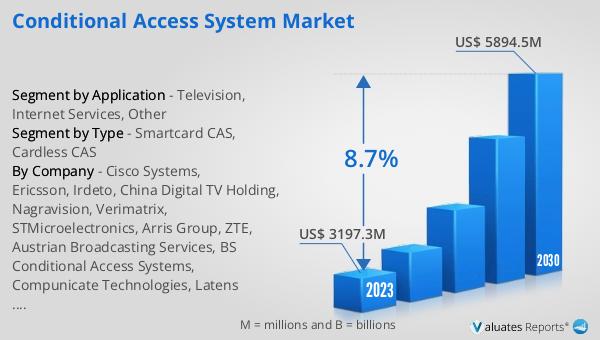What is Global Conditional Access System Market?
The Global Conditional Access System Market is essentially a technology used to control and manage access to digital television (DTV) services, ensuring that only authorized subscribers can access the content they have paid for. This system is crucial in the digital broadcasting industry, where it helps to protect and monetize content. A Conditional Access System (CAS) can be thought of as a digital key that unlocks encrypted television content. When a broadcaster transmits content, it is encrypted, and only viewers who have the correct key, provided by their CAS, can decrypt and view the content. This system plays a pivotal role in preventing unauthorized access to paid television services, thereby safeguarding revenues for service providers and content creators. As the digital broadcasting sector continues to expand globally, driven by increasing demand for high-quality and exclusive video content, the importance of effective conditional access systems is more pronounced than ever. This market's growth is fueled by the continuous advancements in broadcasting technologies, the transition from analog to digital broadcasting, and the rising adoption of high-definition television (HDTV) services among consumers worldwide.

Smartcard CAS, Cardless CAS in the Global Conditional Access System Market:
Diving deep into the Global Conditional Access System Market, we find two primary types: Smartcard-based CAS and Cardless CAS. Smartcard-based CAS, as the name suggests, relies on a physical card inserted into the subscriber's set-top box. This card contains the decryption keys and subscriber's access rights, communicating with the broadcaster's system to unlock the content. This method has been popular due to its physical security features and ease of distribution and management. However, it's not without its drawbacks, such as the cost of producing and distributing the cards and the potential for physical damage or loss. On the other hand, Cardless CAS eliminates the need for a physical card by embedding the conditional access software directly into the set-top box. This approach offers enhanced security against piracy, as it's harder to tamper with, and reduces operational costs related to card production and distribution. Moreover, cardless systems can be updated remotely, allowing for more agile responses to security threats. Both systems aim to protect content and ensure that only paying subscribers can access it, but they do so in ways that reflect different trade-offs between security, cost, and convenience. As the market evolves, the choice between smartcard-based and cardless CAS systems will likely depend on the specific needs and circumstances of each broadcaster and their audience.
Television, Internet Services, Other in the Global Conditional Access System Market:
The Global Conditional Access System Market finds its application across various domains, notably in Television, Internet Services, and other areas. In Television, CAS is indispensable for both satellite and cable TV providers, enabling them to offer tiered subscription packages and pay-per-view services. By controlling who can access which channels or content, providers can tailor their offerings to different market segments, enhancing customer satisfaction and revenue. In the realm of Internet Services, CAS plays a crucial role in managing access to premium online content. As streaming services proliferate and the appetite for on-demand content grows, CAS helps ensure that only subscribers who have paid can access exclusive series, movies, or live events, thus protecting the revenue streams of content creators and distributors. Beyond these, CAS is also applied in other areas, such as controlling access to digital radio broadcasts, premium digital publishing content, and even in some cases, software as a service (SaaS) applications. This wide-ranging applicability underscores the versatility and importance of CAS systems in today’s digital content distribution ecosystem, where protecting intellectual property and ensuring fair compensation for content creators are paramount.
Global Conditional Access System Market Outlook:
Regarding the market outlook for the Global Conditional Access System, it's noteworthy that the sector was valued at approximately $3197.3 million as of 2023. Looking ahead, projections suggest a promising growth trajectory, with expectations to reach around $5894.5 million by the year 2030. This anticipated growth, marked by a Compound Annual Growth Rate (CAGR) of 8.7% during the forecast period from 2024 to 2030, underscores the dynamic nature of the market. Such expansion can be attributed to several factors, including the ongoing shift from analog to digital broadcasting, the increasing demand for high-definition content, and the continuous evolution of content delivery technologies. These trends reflect the growing importance of secure and efficient conditional access systems in enabling content providers to protect their offerings while delivering value to authorized subscribers. As the digital landscape evolves, the CAS market is set to play a crucial role in shaping the future of content consumption and distribution.
| Report Metric | Details |
| Report Name | Conditional Access System Market |
| Accounted market size in 2023 | US$ 3197.3 million |
| Forecasted market size in 2030 | US$ 5894.5 million |
| CAGR | 8.7% |
| Base Year | 2023 |
| Forecasted years | 2024 - 2030 |
| Segment by Type |
|
| Segment by Application |
|
| By Region |
|
| By Company | Cisco Systems, Ericsson, Irdeto, China Digital TV Holding, Nagravision, Verimatrix, STMicroelectronics, Arris Group, ZTE, Austrian Broadcasting Services, BS Conditional Access Systems, Compunicate Technologies, Latens Systems, Conax Technology |
| Forecast units | USD million in value |
| Report coverage | Revenue and volume forecast, company share, competitive landscape, growth factors and trends |
